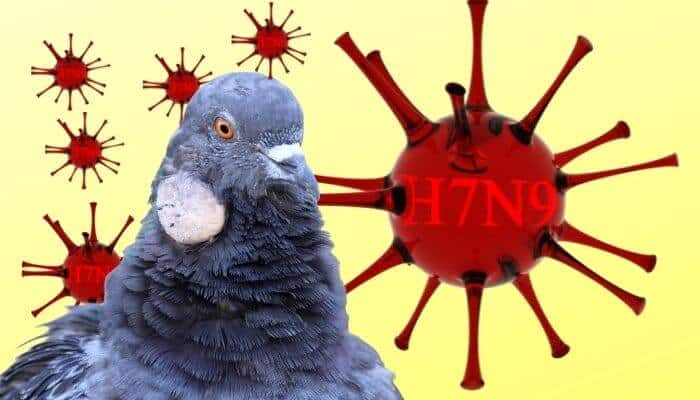Bird flu / avian flu is an infectious type of influenza that spreads among birds.
It does not discriminate between bird species so pigeons can certainly catch it.

As well as being potentially fatal for pigeons (and all birds) in severe cases, it can also be passed to humans.
If you are a pigeon owner, you need to be educated in the basics of bird flu.
Bird flu is a notifiable disease in the UK so if your pigeons are diagnosed or you suspect your birds have it, it must be reported to the Animal and Plant Health Agency.
In the USA, the reporting requirements are localized to each state so the local state agency should be contacted.
A Bit of Bird Flu History
Bird flu is a serious issue, most particularly because it affects poultry stocks and therefore, a major food supply.
Because of this, there is always a strong government response to any outbreak.
As recently as November 2021, a bird flu prevention zone was declared across Great Britain following outbreaks in Scotland and Wales in both poultry flocks and wild birds.
Although there is little risk of the disease communicating to humans, all bird owners are expected to tighten up their biosecurity measures.
The avian flu that causes so much concern was first identified in Southern China in 1996.
The viruses considered most severe are those that are communicable for humans.
The first major virus was identified as A(H5N1) and was deemed highly pathogenic. To 2016, according to the World Health Organisation, there have been 440 deaths from 826 diagnosed cases of A(H5N1) bird flu in humans.
Since 1996, various strains of varying pathogeny have developed with a number of significant outbreaks, some confirmed to birds, other involving human infection and fatality. The WHO timeline charts the history of (H5N1) avian flu since 1996.
What Is Bird Flu?
In the simplest possible terms, bird flu is a type of influenza that can be caught by birds of all breeds and species.
For birds, this type of flu is very severe, and in the most dangerous of cases can even be fatal.
Evidence has proven that while the vast majority of birds are susceptible and vulnerable to contracting bird flu, the kind of bird that is most directly and fatally affected by the disease is poultry.
Many species of wildfowl and water birds carry the virus without it doing them harm, but it is easily transmittable to chickens, turkeys, ducks and geese.
What Are the Symptoms of Bird Flu?
There are a number of different symptoms that indicate the presence of bird flu.
The most significant of these symptoms include:
- A sudden increase in birds found dead within your owned population.
- Similarity in illness of birds that share the same shed space.
- Swollen heads.
- Eyes that are overly watery or closed.
- Increased lethargy.
- Increased unresponsiveness.
- A loss of balance and coordination.
- Tremors in the body and/or head.
- Dredging legs or drooping wings.
- Twisting of the neck and head.
- New blue colouring of the wattles and comb, often combined with swelling.
- Loss of appetite.
- Change in water consumption, either increase or decrease.
- Respiratory issues including mouth breathing, nasal snicking, gurgling, rattling and sneezing.
- Fever.
- Loose watery droppings.
- Extreme reduction in egg production.
What Are the Effects of Bird Flu?
Reading through the above-mentioned symptoms should give you a good idea of what this flu can do to a bird.
Factors like fever and respiratory problems combine to make the bird extremely uncomfortable.
The virus can become so powerful within a weakened bird’s body that its system fails to support itself and the bird eventually dies.
Some bird species are able to fight the influenza to the point where the symptoms start to subside, but others, including most poultry, tend to not be quite as lucky.
How Can You Prevent Bird Flu?
Though it is difficult to prevent bird flu from occurring in pockets among the wild population, some of the things that bird owners can do in order to reduce the risk of an outbreak include:
- Fencing off any ponds, bogs, streams or patches of standing water, or even better, draining them if possible.
- Netting off or covering undrainable ponds.
- Attempting to deter wild birds from interacting with you by using things like predator decoys.
- Cleaning and disinfecting any concrete areas that your birds have access to.
- Laying down absorbent wood shavings in especially wet areas.
- Trying to limit the number of different people that come in and out of your bird site on a regular basis.
- Installing disinfectant foot dips at the entrances and exits of your bird enclosures.
How Can You Treat Bird Flu?
The most unfortunate thing about bird flu is the fact that there is currently no readily available treatment for the disease.
In theory, a vaccine could be produced to help fight it, but the truth is that by the time it could become commercially viable in most countries, the virus would have mutated into something that was no longer effectively contained.
Vaccination in the UK is not currently permitted (except for zoo birds).
Sadly, the most common outcome of a bird flu outbreak among a particular pocket or population is having to cull them.
The majority of countries operate under a strict culling policy when any proof of bird flu has been established, and that is why bird owners everywhere should take the prevention advice as seriously as possible.
What Is the Relationship Between Pigeons and Bird Flu?
A slight glimmer of good news, however, is that when it comes to pigeons in particular, bird flu does not appear to be as much of a concern compared to other breeds.
On the spectrum of infection, pigeons are on the lower end in terms of becoming infected and/or continuing to be infectious.
Pigeons are considered to be less susceptible to avian influenza, with the virus, as we highlighted, being much more dangerous to the various breeds of poultry.
Humans and Bird Flu
Pigeon owners should be acquainted with the facts about bird flu not only for their pigeons but also to be able to prevent it, recognize the symptoms and what to do if diagnosed with it themselves.
There are four strains of influenza that are known as avian flu that can be transmitted to humans:
- H5N1 (since 1997)
- H7N9 (since 2013)
- H5N6 (since 2014)
- H5N8 (since 2016)
According to the World Health Organisation, the H5N1 strain was first discovered in humans in 1997. At the time of writing, bird flu (all strains) has proved fatal in 60% of human infections.
Bird flu is spread to humans by contact with an infected bird. It is not spread from human to human.
You should also note that any of the seasonal flu vaccines provided by the NHS in the UK offer no protection against bird flu.
Preventing bird flu in humans
- Avoid touching sick birds (wear gloves and a mask to handle them)
- Avoid touching bird droppings (mask and gloves should be worn)
- Do not eat infected birds or their eggs
Symptoms of bird flu in humans
- a very high temperature
- feeling hot or shivery
- aching muscles
- headache
- a cough or shortness of breath
Treatment of bird flu in humans
An infection will need to be confirmed and this is through tests.
If confirmed, antiviral drugs such as oseltamivir (Tamiflu) or zanamivir (Relenza) will be prescribed and you may also be isolated in hospital.

This article was written by our qualified veterinarian Cristina.
This is part of our commitment to providing you with the most trustworthy veterinary advice for your pigeons.
The Takeaway
Bird flu can be fatal to birds and humans.
If you keep pigeons, there is an onus on you to be informed of any issues associated with bird flu and also to take preventative measures as advised by the relevant government/federal and state agencies.
Sources:
